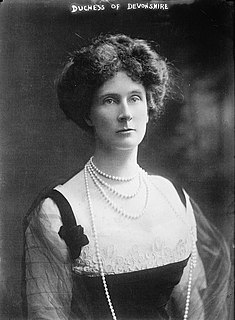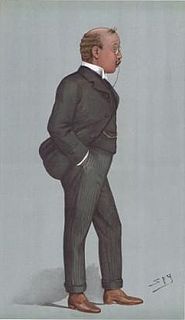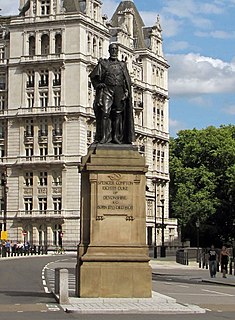Related Research Articles

Duke of Devonshire is a title in the Peerage of England held by members of the Cavendish family. This branch of the Cavendish family has been one of the wealthiest British aristocratic families since the 16th century and has been rivalled in political influence perhaps only by the Marquesses of Salisbury and the Earls of Derby.

William Cavendish, 4th Duke of Devonshire,, styled Lord Cavendish before 1729, and Marquess of Hartington between 1729 and 1755, was a British Whig statesman and nobleman who was briefly nominal Prime Minister of Great Britain. He was the first son of William Cavendish, 3rd Duke of Devonshire and his wife, Catherine Hoskins. He is also a great-great-great-great-great-grandfather of King Charles III through the king's maternal grandmother.

William Cavendish, 7th Duke of Devonshire,, styled as Lord Cavendish of Keighley between 1831 and 1834 and known as Earl of Burlington between 1834 and 1858, was a British landowner, benefactor, nobleman, and politician.

Spencer Compton Cavendish, 8th Duke of Devonshire,, styled Lord Cavendish of Keighley between 1834 and 1858 and Marquess of Hartington between 1858 and 1891, was a British statesman. He has the distinction of having held leading positions in three political parties: leading the Liberal Party, the Liberal Unionist Party and the Conservative Party in either the House of Commons or the House of Lords. After 1886 he increasingly voted with the Conservatives. He declined to become prime minister on three occasions, because the circumstances were never right. Historian and politician Roy Jenkins said he was "too easy-going and too little of a party man." He held some passions, but he rarely displayed them regarding the most controversial issues of the day.

Lieutenant-Colonel Lord Edward Cavendish MP was a 19th-century British politician, soldier, and nobleman.
This is a list of people who have served as Lord Lieutenant of Derbyshire. Since 1689, all the Lord Lieutenants have also been Custos Rotulorum of Derbyshire.

Evelyn Emily Mary Cavendish, Duchess of Devonshire, was the wife of Victor Cavendish, 9th Duke of Devonshire. She was the elder daughter of politician and diplomat Henry Petty-Fitzmaurice, 5th Marquess of Lansdowne and grew up amidst public life. Evelyn's marriage to Cavendish, nephew and heir presumptive of Spencer Cavendish, 8th Duke of Devonshire, led to her becoming Duchess of Devonshire in 1908. With her position, she oversaw the reorganisation of the Devonshire estates and presided over four English houses and one Irish castle.

Lord Richard Frederick Cavendish,, known as Richard Cavendish until 1908, was a British aristocrat, author, magistrate, and politician.
The 232rd Infantry Brigade was a formation of the British Army during both the First and the Second World Wars.

Lord George Augustus Cavendish was a British nobleman, politician, and a member of the House of Cavendish.
Devonshire is an alternative and formerly official name for Devon, a county in South West England.

The Cavendishfamily is a British noble family, of Anglo-Norman origins. They rose to their highest prominence as Duke of Devonshire and Duke of Newcastle.
The 1892 Rossendale by-election was a parliamentary by-election held for the British House of Commons constituency of Rossendale in Lancashire on 23 January 1892. It was one of the most important political contests in the struggle over Irish Home Rule and a pointer to the outcome of the 1892 general election which took place in July.

The Devonshire Dome building is a Grade II* listed 18th-century former stable block in Buxton, Derbyshire. It was built by John Carr of York and extended by architect Robert Rippon Duke, who added what was then the world's largest unsupported dome, with a diameter of 44.2 metres (145 ft). It is now the site of the Buxton Campus of the University of Derby.

John Harper (1809–1842) was an English architect.

The statue of the Duke of Devonshire is a Grade II-listed outdoor bronze sculpture of Spencer Cavendish, 8th Duke of Devonshire, the leader of three British political parties between 1875 and 1903, and is located at the entrance to Horse Guards Avenue, Whitehall, London, England. A work of the sculptor Herbert Hampton, it was unveiled in 1911.

'Worcester Pearmain' is an early season English cultivar of domesticated apple, that was developed in Worcester, England, by a Mr. Hale of Swanpool in 1874. It was once the most popular cultivar in England for early autumn harvest and is still popular to keep in the garden. It has been extensively used in apple breeding.

The Devonshire Royal Hospital was established as the Devonshire Hospital in 1859 in Buxton, Derbyshire by the Buxton Bath Charity for the treatment of the poor. The hospital was built in the converted stable block of The Crescent. The building is now known as the Devonshire Dome and it is the site of the Buxton Campus of the University of Derby.

The Devonshire Quarrenden is a dessert apple cultivar historically grown and probably originating in England, although it has also been suggested as originating in France. A variety of local names and spellings, including "Red Quarrenden", "Quarrington", "Quarender", and the "Sack Apple", have been recorded in the past.
References
- ↑ "Duke of Devonshire". Pomiferous.
- ↑ Hoog, Robert (1875). The Fruit Manual.
- ↑ Bultitude, John (1983). Apples.